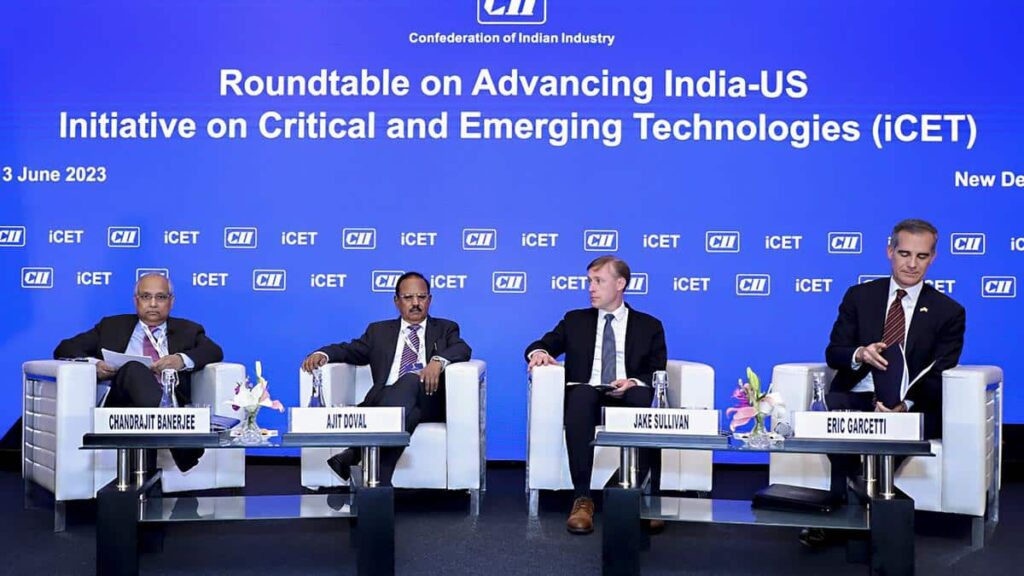India – U.S. iCET Initiative 2023 – Important UPSC CSE Topic
India – US recently launched iCET Initiative. The iCET stands for Initiative on Critical and Emerging Technologies (iCET). This is a bilateral initiative to strengthen strategic technology partnership between India and the USA in critical and emerging areas. Read more about iCET below.
About iCET Initiative
- Led by Indian National Security Council Secretariat and U.S. National Security Council.
- Launched in 2023 and jointly announced by US President Joe Biden and Indian Prime Minister Narendra Modi.
- Supported by academia, industries, and startups. Involves key players such as Indian Semiconductor Mission, US Semiconductor Industry Association (SIA) and Indian and US tech companies.
- Major key areas of cooperation of this initiative –
- Artificial Intelligence (AI)
- Quantum Computing
- Semiconductors
- Defence Innovation & Space
- 5G/6G Technologies
- Clean Energy
- Human Spaceflight
- Biotechnology, critical minerals, rare earth mineral processing, and digital technology have recently been added to the focus areas.
- These key areas of cooperation would gradually be expanded to QUAD, then to NATO, followed by Europe and the rest of the world.

Strategic Significance of the India-US iCET Initiative
- Counterbalancing China’s Tech and Geopolitical Influence
- Both India and the US see rise of China in critical technologies as strategic challenge for both the countries (like AI, quantum, cyber, and 5G).
- iCET will help build trusted supply chains and technological ecosystems to reduce dependence on Chinese tech.
- iCET will help to enhance India’s role as a strategic partner in the Indo-Pacific.
- Defence and Security Cooperation
- iCET brings cutting-edge defence tech collaboration, including co-development and co-production.
- It supports India’s defence modernization through joint R&D and technology transfer.
- It encourages linkages between US DoD and India’s DRDO and private defense startups.
- Semiconductor Supply Chain Resilience
- Post-COVID, the world realized the fragility of semiconductor supply chains.
- It aims to build resilient and trusted semiconductor infrastructure in India with US support (e.g., fab units, chip design).
- It helps India as a global chip manufacturing hub.
- Aatmanirbhar Bharat
- India seeks to become self-reliant in critical technologies — iCET aids in this mission.
- It will help to reduce dependencies on unreliable partners or hostile regimes.
- Aligns with India’s Aatmanirbhar Bharat and Digital India initiatives.
- Space Cooperation
- iCET enhances cooperation between ISRO and NASA in satellite communication, planetary defence, and space exploration.
- Supports India’s space sector liberalization and private space startups.
- Geopolitical Alignment
- Reinforces India’s image as a trusted democratic tech partner.
- Strengthens the India-US Comprehensive Global Strategic Partnership.
- Complements other bilateral/multilateral frameworks like QUAD, IPEF, and Clean Network Initiative.
Recent Developments in iCET Initiative (2024–25)
- Joint ventures in semiconductor manufacturing.
- Collaboration between ISRO and NASA for space missions.
Challenges of iCET Initiative
- Tech transfer Barriers
- US export control laws (e.g., ITAR) restrict the transfer of sensitive technologies.
- India still lacks certain designations like Major Non-NATO Ally (MNNA) or STA-1 for all sectors, limiting access to high-end defence and dual-use tech.
- Differences in IPR protection, data governance, and cyber laws can slow progress.
- India’s complex regulatory ecosystem, slower approvals, and red tape deter smooth collaboration.
- US firms are global tech leaders, while many Indian firms are still developing R&D capacity in frontier technologies.
- Different Strategic Priorities
- The US often views tech partnerships through a geopolitical and security lens (especially to counter China).
- India prioritizes strategic autonomy and is cautious about alignment with military blocs. Thus, this mismatch can create friction in policy execution and expectations.
- The legacy of India–Russia defence ties and non-alignment policy sometimes leads to hesitations in deep tech-military cooperation.
- Semiconductor Ecosystem Gap
- India lacks advanced fabrication capabilities, skilled workforce, and supporting infrastructure.
- Even with US investment interest, building a full semiconductor value chain will take time and faces logistical and technical challenges.
- Cybersecurity & Data Localization Issues
- India prefers data localisation and strong data sovereignty while the United States prefers free data flows.
- Cooperation in AI and cloud computing is hindered by lack of common standards and regulations.
- Capacity and Funding
- India’s R&D investment as a % of GDP (~0.7%) is low compared to the US (>2%).
- Scaling up collaboration in cutting-edge tech areas requires long-term financial and human capital investment.
- Political Instability
- Shifts in US administrations can lead to policy unpredictability (e.g., Trump-era visa issues, Biden’s CHIPS Act).
- Domestic politics or human rights concerns may also affect tech relations.
Way Forward for iCET Initiative
- Need of Regulatory Frameworks
- India needs to get simplified export control and licensing procedures from US side.
- Harmonize policies related to IPR, cybersecurity, and data protection to enable smoother collaboration.
- Reforms in Tech Transfer Barriers
- Differences should be reduced in IPR protection, data governance, and cyber laws.
- Need to reform US export control laws (e.g., ITAR).
- Strengthen transparency and confidence-building measures, especially in defence and dual-use technologies.
- Ensure balance between data protection and cross-border data flows to support innovation.
- Need of Capacity Building
- Need of investment in R&D Infrastructure such as AI, quantum, semiconductors, and advanced materials.
- Promote skill development programs in emerging tech fields through various India-US partnership programs.
- Encourage private sector participation from both countries via joint ventures, innovation funds, and startup accelerators.
- Facilitate easier market access, digitalisation, investment, and technology transfer.
- Need to fill Semiconductor Ecosystem Gap soon
- With the help of US tech leaders, accelerate implementation of India’s Semiconductor Mission.
- Focus on design, testing, packaging, and R&D until full fabrication capabilities are built.
- Investment in Space and Defence Cooperation
- Expand collaboration between ISRO–NASA and DRDO–US DoD on key frontier missions.
- Develop frameworks for co-development and co-production of defence technologies and equipment.
- Use platforms like QUAD and IPEF to reinforce commitment.